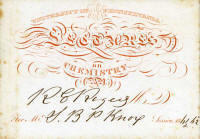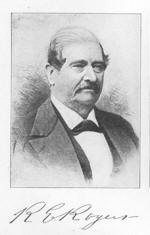Robert
Empie Rogers, M.D.

Click image to enlarge
Go to lecture card display
 Rogers, Robert Empie (1813-1884). Rogers, Robert Empie (1813-1884).
Robert Empie Rogers was born in
Baltimore, Maryland, March 29, 1813. The middle name "Empie" was
assumed by him "as a lasting token of his grateful appreciation of
parental care bestowed upon him at William and Mary College after
the death of his mother Empie and his wife." His father, Patrick
Kerr Rogers, (q. v.), came to Philadelphia from Ireland in August,
1798.
The early education of Robert was
directed by his father, and upon his death by his brothers, James
and William, at a school conducted by them at Windsor, Maryland,
where he remained until 1828, when he matriculated at Dickinson
College, leaving there to continue his studies at William and Mary
College. In 1831 he went to New England and was employed in railway
surveying and later in delivering lectures on chemistry in New York
City, resuming surveying near Boston, Massachusetts, in 1833.
In the fall of 1833 he entered
the Medical School of the University of Pennsylvania and became a
pupil of Professor Robert Hare, and in March, 1836, received his
medical degree. The title of his graduating thesis was "Experiments
on the blood, together with some new facts in regard to animal and
vegetable structure illustrative of many of the most important
phenomena of organic life, among them respiration, animal heat,
venous circulation, secretion, and nutrition." It was published in
the American Journal of the Medical Sciences (vol. xviii, p. 277).
Most attention was given the phenomena of respiration. It received
from the faculty to which it was presented the recognition it so
well deserved. After the attainment of the doctorate it soon became
apparent that the practice of his profession was not to his taste.
He gave himself wholly to chemistry, and from 1836 to 1842 served as
chemist to the first Geological Survey of Pennsylvania, his brother
Henry being the head of that survey. He was acting instructor of
chemistry in the University of Virginia, 1841-42, when elected
professor of general and applied chemistry and materia medica in the
same University, a position he held until 1852. On March 13, 1843,
he married Fanny Montgomery, daughter of Joseph S. Lewis of
Philadelphia, Pennsylvania.
During this period, in
conjunction with his brothers, James and William, he was active in
various chemical investigations of unusual merit that were published
in the scientific journals. With his brother James he compiled, from
the works of Turner and Gregory, a volume designed to be a textbook
on chemistry; it included both inorganic and organic chemistry, and
appeared in 1846.
The first shock in the way of
dissolution of the close affinity of these interesting brothers
happened in 1852, when James, then professor of chemistry in the
University of Pennsylvania, was claimed by death. But his work was
to be transferred to a brother, for in August of the same year
Robert was elected to fill his place and in 1856 became the dean of
the medical faculty.
In 1855 he published his American
edition of Lehmann's monumental work on physiological chemistry. In
the years immediately following he was engaged in expert work of
various kinds.
From
1862 to 1863 was an acting assistant surgeon, U. S. A., assigned to
the Satterlee Military Hospital in Philadelphia, where in January of
the latter year he sustained the loss of his right hand while
showing a woman the dangers which beset her in feeding a steam
mangle. A deeper sorrow
came to him when his wife died, February 21, 1863. He remarried in
April, 1866, Delia Saunders of Providence, R. I.
About the time of the removal of
the University of Pennsylvania to the west side of the Schuylkill
River, certain proposed changes in the administration of the medical
school caused more or less discontent among the professors. Doctor
Rogers, after serving for a period of a quarter of a century,
quietly resigned, and accepted in 1877 an election to a similar
chair in Jefferson Medical College. This position he held until
1884, when he became emeritus professor, but died shortly after, in
the same year, September 6, aged nearly seventy-two years. His
second wife had preceded him the year before.
Doctor Rogers was a member of the
Academy of Natural Sciences of Philadelphia and was most active in
its affairs. He helped to organize the Association of American
Geologists and Naturalists in 1840, which in 1847 became the
American Association for the Advancement of Science. He was a member
of the American Medical Association; the American Philosophical
Society and served in the council; a fellow of the College of
Physicians; chemist to the gas trust of Philadelphia from 1872-1884;
member of the annual U. S. Assay Commission 1874-79; member of the
Franklin Institute, and its president 1875-1879.
Besides his literary
contributions, Doctor Rogers was also "author of many inventions,
notable among them, the Rogers and Black steam boiler, and of
several modifications and improvements of electric apparatus."
He was an original member of the
National Academy of Sciences.
|